Non-government sources
On this page:
In 2021–22, non-government sources spent $65.3 billion on health (Figure 17a), a 2.4% decrease in real terms compared to the previous year. Individuals contributed $33.7 billion, just over half (51.5%) of non-government health spending, private health insurance providers $17.5 billion (26.8%) and other non-government sources $14.2 billion (21.7%).
It is likely that COVID-19 restrictions and temporary suspension of non-urgent elective surgery and non-essential treatments in most states and territories resulted in lowering spending by individuals, private health insurance providers, and other non-government entities in 2021–22. However, note that the actual non-government health spending was below the 10-year historical trend before the pandemic (2008–09 to 2018–19, Figure 17b).
Figure 17a: Non-government health spending, constant prices (a), by source of funds, 2011–12 to 2021–22
The line graph shows that spending by individuals increased each year and overall, from $27.6 billion in 2011–12 to $33.7 billion in 2021–22. Spending by private health insurance funds also increased each year and overall from $13.0 billion in 2011–12 to $17.5 billion in 2021–22. Apart from the decrease in 2016–17, over the 10-year period other non-government spending increased overall from $10.1 billion in 2011–12 to $14.2 billion in 2021–22.
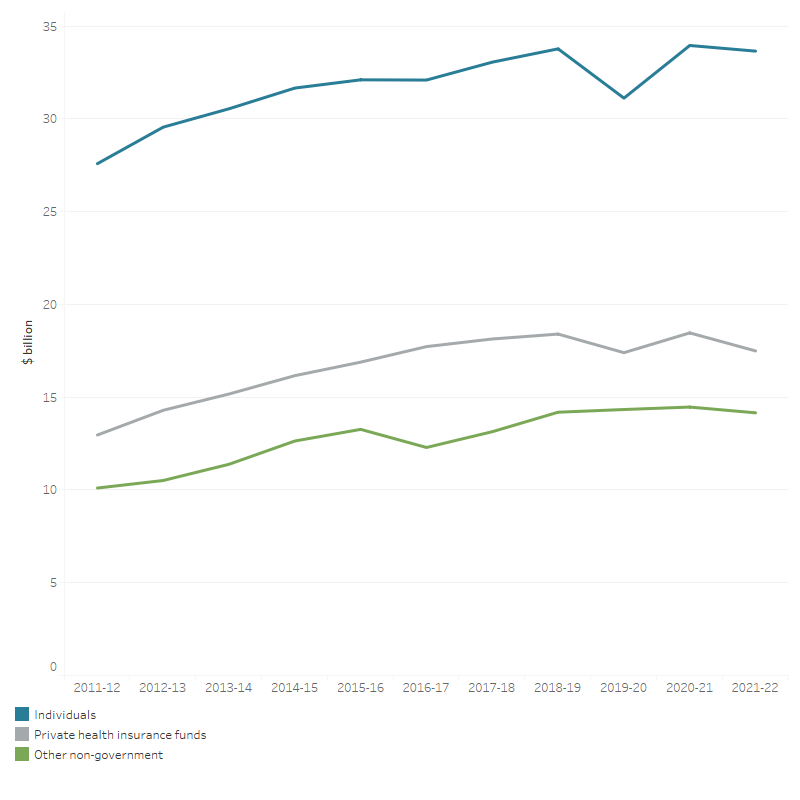
(a) Constant price health spending is in 2021–22 prices.
Notes
- Funding by private health insurance funds excludes the Australian Government private health insurance premium rebate.
- Other non-government refers to spending on health goods and services by injury compensation insurers and other sources of private income. All non-government sector capital spending is also included here since the funding sources of non-government capital spending are not known. If funding sources were known, this capital spending would be spread across all non-government funding sources.
Source: AIHW Health Expenditure Database (Table 19).
Figure 17b: Non-government health spending, constant prices, during the COVID-19 pandemic (2019–20 to 2021–22) compared with the pre-pandemic period
The line graph shows the total non-government health spending, in the three years during the COVID-19 pandemic (2019–20 to 2021–22) compared to the trend of the previous 10-year period (2008–09 to 2018–19). Assuming the average growth rate for the previous 10-year period remains the same from 2019–20 to 2021–22, the trend amounts of non-government health spending in constant prices from 2019–20 to 2021–22 were $69.1 billion, $72 billion, and $75.0 billion respectively. While the actual amounts for these years were $62.9 billion, $66.9 billion, and $65.3 billion, respectively.
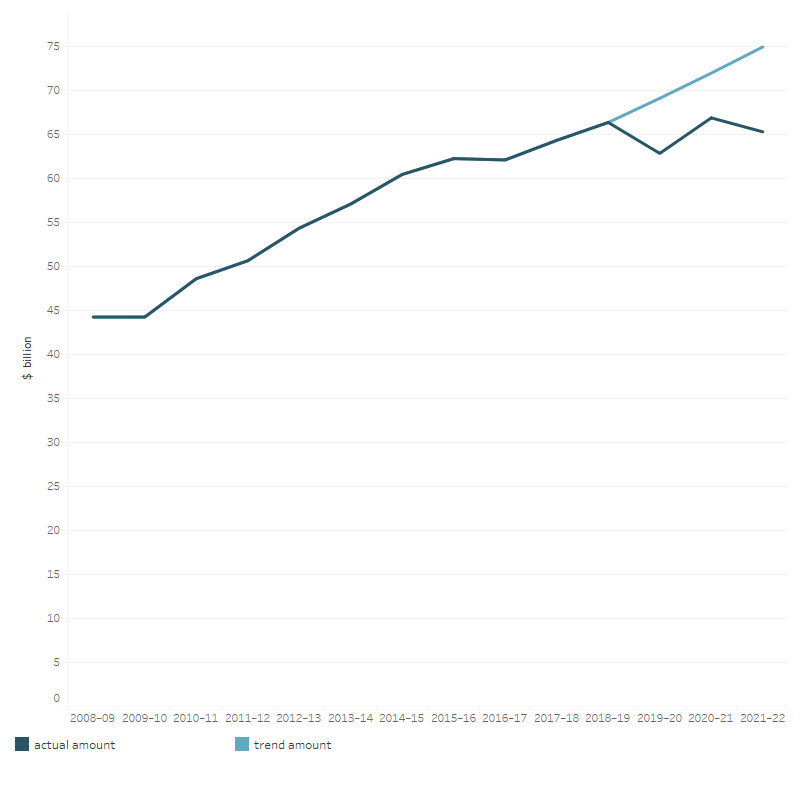
Notes
- Actual amount is the health spending in 2021–22 prices.
- Trend amount refers to the heath spending in 2021–22 prices, following the trend of the previous 10-year period (assuming the average annual growth rate for the previous 10-year period remains the same for the period from 2019–20 to 2021–22).
- Funding by private health insurance funds excludes the Australian Government private health insurance premium rebate.
- Other non-government refers to spending on health goods and services by injury compensation insurers and other sources of private income. All non-government sector capital spending is also included here since the funding sources of non-government capital spending are not known. If funding sources were known, this capital spending would be spread across all non-government funding sources.
Source: AIHW Health Expenditure Database (Table 19).
Individual spending
Individuals spent an estimate of $33.7 billion out-of-pocket on health goods and services in 2021–22. This was 0.9 percentage points less than in 2020–21 in real terms (Table 20). Once again note that the actual health spending by individuals was still below the 10-year trend before the pandemic (2008–09 to 2018–19, Figure 18b).
In 2021–22, individuals spent an estimate of $11.8 billion (35.1%) on medications not subsidised through the PBS, including over-the-counter medications, vitamins and health-related products. Another $6.7 billion (19.8%) was spent on dental services and $5.0 billion (14.9%) on both referred and unreferred medical services (Table 20).
Individuals’ spending on private hospitals decreased by 10.3% compared to 2020–21, most likely due to COVID -19 restrictions on access to private hospitals for non-urgent elective surgery in 2021–22.
Per person individual health spending
Health spending by individuals equated to an average of $1306 per person in 2021–22.
This was made up of:
- $459 on non-subsidised medications
- $259 on dental services
- $195 on referred and unreferred medical services
- $135 on hospital services
- $121 on aids and appliances
- $61 on medications partly subsidised by the PBS
- $45 on health practitioners, such as chiropractors, optometrists, practice nurses and physiotherapists (Figure 18a).
This annual per person spending decreased by 1.4% in 2021–22 in real terms, $19 less than in 2020–21.
Figure 18a: Average (a) per person individual health expenditure, by area of expenditure, constant prices (b), 2011–12 to 2021–22
The line graph shows per person health spending by individuals for hospitals, patient transport services, medical services, dental services, other health practitioners, community and public health, benefit-paid pharmaceuticals, all other medications and aids and appliances from 2011–12 to 2021–22. In 2021–22, per person health spending increased for all other medications, medical services, dental services, patient transport services, and community and public health while decreasing for other areas of spending as compared to 2020–21. Over the 10-year period, per person health spending by individuals on all other medications increased by a relatively larger amount from $375.5 in 2011–12 to $458.7 in 2021–22. Per person spending by individuals on hospitals steadily increased from $124.8 in 2011–12 to $152.9 in 2020–21 before declining to $135.5 in 2021–22. Per person health spending by individuals on other practitioners increased from $131.2 in 2011–12 to $137.1 in 2012–13, and then decreased to $44.8 in 2021–22.
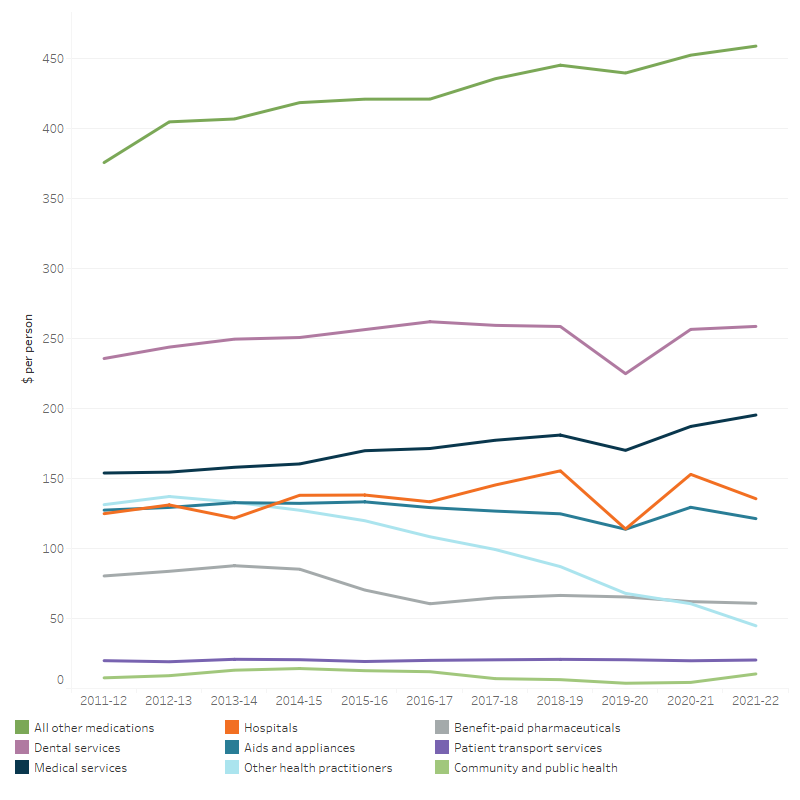
(a) Based on ABS annual estimated resident population (Table37).
(b) Constant price health spending is in 2021–22 prices.
Note: Medical services refers to both referred and non-referred medical services.
Source: AIHW Health Expenditure Database (Table 21).
Figure 18b: Individuals health spending, constant prices, during the COVID-19 pandemic (2019–20 to 2021–22) compared with the pre-pandemic period
The line graph shows the total individual health spending, in the three years during the COVID-19 pandemic (2019–20 to 2021–22) compared to the trend of the previous 10-year period (2008–09 to 2018–19). Assuming the average growth rate for the previous 10-year period remains the same from 2019–20 to 2021–22, the trend amounts of individuals health spending in constant prices for 2019–20, 2020–21, and 2021–22 were $35.2 billion, $36.6 billion, and $38.1 billion respectively. While the actual amounts for these years were $31.1 billion, $34.0 billion, and $33.7 billion, respectively.

Notes:
- Actual amount is the health spending in 2021–22 prices.
- Trend amount refers to the heath spending in 2021–22 prices, following the trend of the previous 10-year period (assuming the average annual growth rate for the previous 10-year period remains the same for the period from 2019–20 to 2021–22).
Source: AIHW Health Expenditure Database (Table 20).
Private health insurance provider spending
During 2021–22, providers of private health insurance financed $17.5 billion (7.3%) of total health spending. More than half ($9.7 billion) was for hospital services, with private hospitals receiving an estimated $8.9 billion. Approximately $3.1 billion was spent on primary health care services (Figure 19).
Spending by the private health insurance providers decreased by 5.3% ($1.0 billion) in 2021–22 in real terms, most likely due to COVID-19 restrictions on access to non-urgent elective surgery and non-essential treatments (dental, optical and other health services) (ACCC, 2022). The average annual growth rate for the decade from 2011–12 was 3.0%.
Note that the private health insurance spending on referred medical services are related to the gap payment for in-hospital MBS services which currently could not be split into public and private hospitals due to data unavailability.
Figure 19: Private health insurance provider health spending by area of spending, constant prices (a), 2011–12 to 2021–22
The line graph shows private health insurance provider health spending for public hospitals, private hospitals, primary health care, referred medical services and other services from 2011–12 to 2021–22. During 2020–21 to 2021–22, there was an overall decrease in private health insurance provider health spending for most areas of spending. In 2021–22, private health insurance provider health spending on private hospitals, primary health care, other services, referred medical services and public hospitals were $8.9 billion, $3.1 billion, $3.0 billion, $1.7 billion and $0.8 billion respectively.
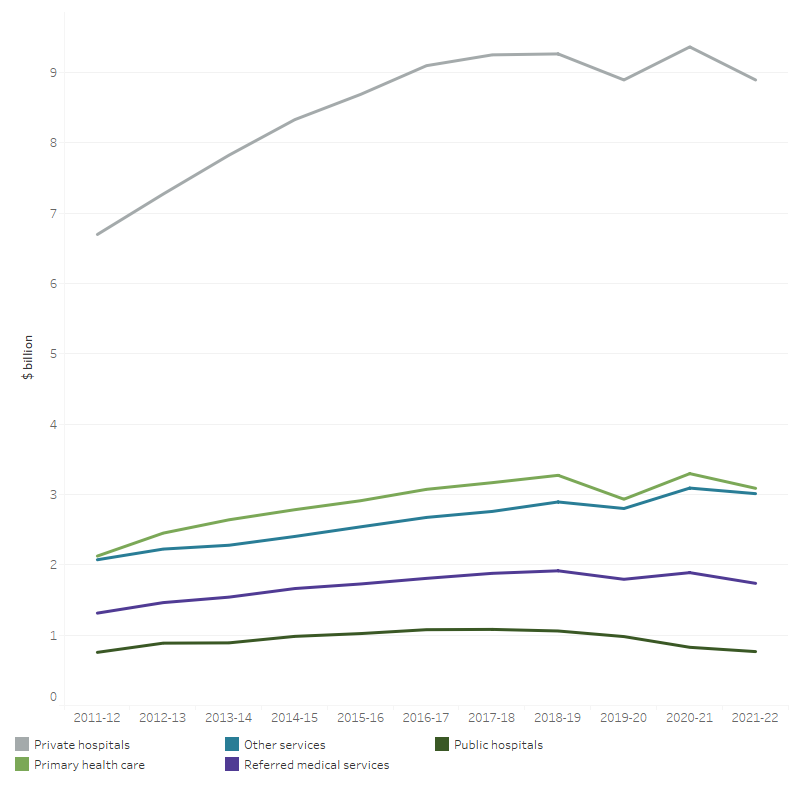
(a) Constant price health spending is in 2021–22 prices.
Notes:
- This shows the payments made by health insurance funds over the year and does not necessarily reflect the actual services provided during the year.
- Other services include patient transport services, aids and appliances, and administration.
Source: AIHW Health Expenditure Database (Table 22).
Private health insurance provider health spending per person covered
In 2021–22, private health insurance providers spent an estimated average of $1,509 per person covered by a private hospital insurance policy. This was a decrease of $115 (7.1%) from 2020–21 in real terms. The average annual growth for the decade to 2021–22 was 2.0% (Figure 20).
Queensland ($1,705), South Australia ($1,691), and Tasmania ($1,664) had the highest spending by private health insurers per person covered, at more than 1.8 times the amount of the Northern Territory ($905) (Figure 20).
Nationally, spending by private health insurers equated to an average of $679 per person in 2021–22, including those not covered by private health insurance. This represented a decrease of 5.8% from 2020–21 in real terms. The average annual growth rate for the decade from 2011–12 was 1.7% (Table 24).
Figure 20: Average per person (a) spending by private health insurance providers for each state and territory, constant prices (b), 2011–12 to 2021–22
The line graph shows that average per person spending by private health insurance providers for all states and territories and Australia from 2011–12 to 2021–22. Between 2020–21 to 2021–22, average per person spending for all state and territories and Australia as the whole nation decreased steadily. In 2021–22, average per person spending by private health insurance providers in New South Wales, Victoria, Queensland, Western Australia, South Australia, Tasmania and Australia as the whole nation was around $1,509. At the same time, average per person spending by private health insurance providers was $1,084 for the Australian Capital Territory and $905 for the Northern territory.
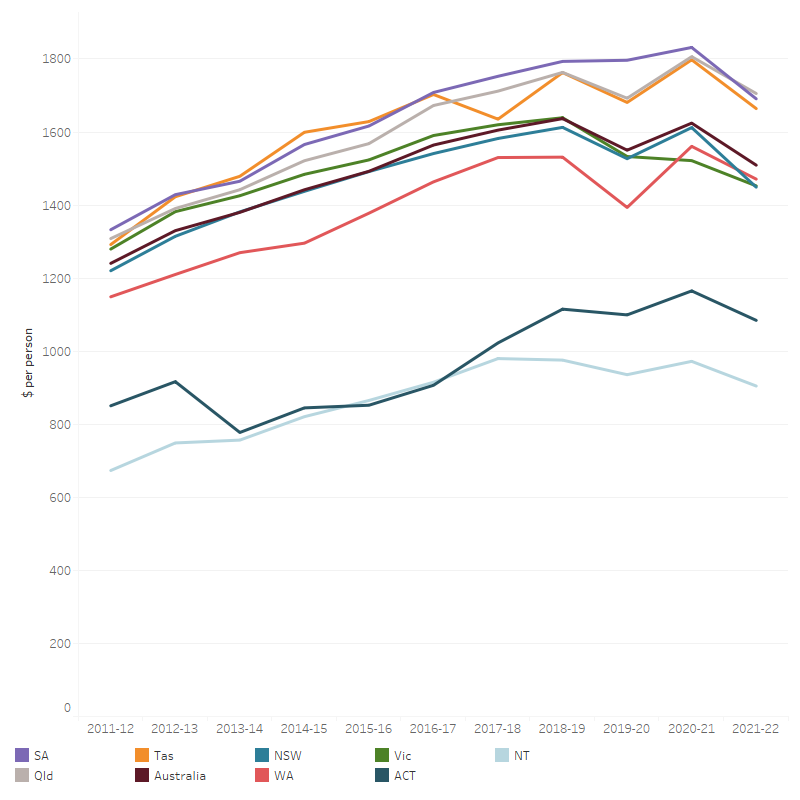
(a) Based on the number of people with private hospital insurance cover living in each state and territory.
(b Constant price health spending is in 2021–22 prices.
Sources: AIHW Health Expenditure Database; Australian Prudential Regulation Authority (2023a, 2023b) (Table 23).
Other non-government spending
In 2021–22, other non‑government sources spent $14.2 billion on health, representing 5.9% of total health spending in the year (Table 10). This showed a decrease of 2.1% compared with 2020–21. The average annual growth rate over the decade to 2021–22 was 3.4%.
During 2021–22, injury compensation insurers spent $3.7 billion on health goods and services: $2.5 billion by workers’ compensation insurers and $1.2 billion by compulsory third‑party motor vehicle insurers (Table 25).
Individuals’ health spending relative to income and wealth
To better understand how health spending is impacting the disposable or readily accessible wealth of people (the ‘out-of-pocket costs’), health spending by individuals is compared with both average incomes and measures of net worth to understand whether, on average across the population, individuals’ health spending is rising relative to personal wealth over time. Note that these are average figures, so the analysis here does not take into account inequality issues in income, wealth, and individuals’ health spending.
In 2021–22, health spending by individuals amounted to an average of $1,306 per person, 1.88% of average annual income, a slight decrease from 2020–21 (1.92%) (Figure 21). On average over the decade, individual health spending increased by 2.1% per year compared to 2.7% per year for the average annual income (in current prices).
Figure 21: Ratio of average individual health spending (a) to average annual income (b), current prices, 2011–12 to 2021–22
The line graph shows that annual growth rate in average individual health spending was positive for all years between 2011–12 and 2021–22 except in 2019–20. In the 10- year period, annual growth rate in average individual health spending ranged from –7.5 per cent to 10.7 per cent. Growth rates in average annual income was positive each year in the 10- year period and ranged between 1.0 per cent and 6.7 per cent. The ratio between average individual health spending per person and average annual income was relatively flat with an average of 2.0 per cent.
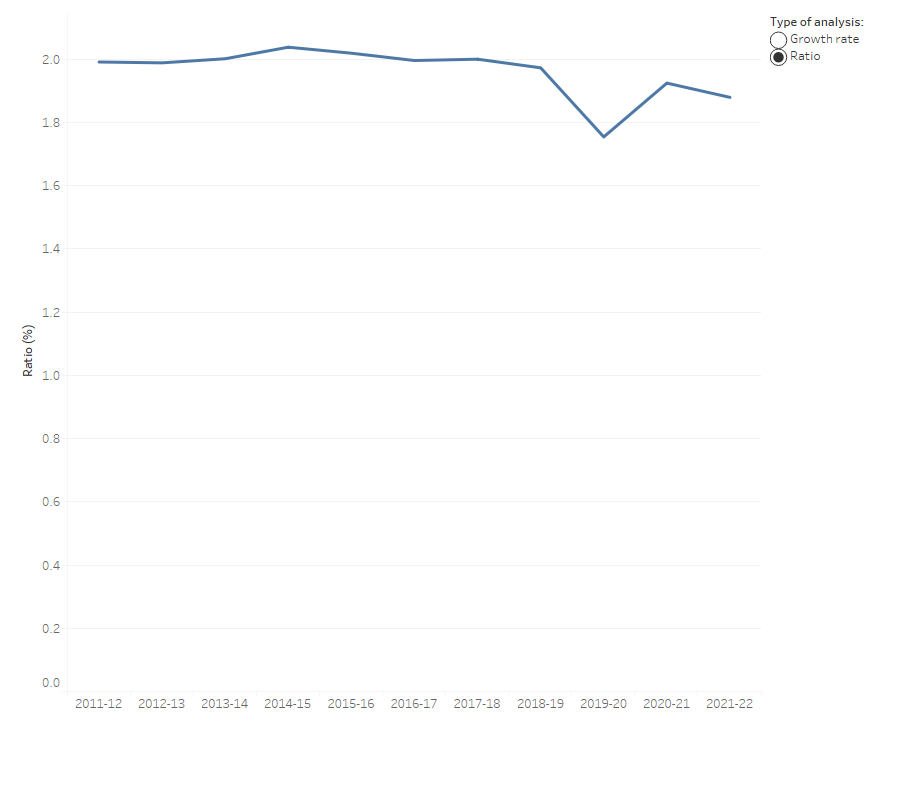
(a) Based on annual estimated resident population (Table 37).
(b) Refers to annualised average weekly earnings.
Sources: AIHW Health Expenditure Database; Australian Bureau of Statistics (2022a, 2023a) (Table 26).
In 2021–22, health spending by individuals represented on average 0.23% of individual net worth, a slight decrease from 2020–21 (0.25%) (Figure 22). In 2021–22, per person net worth grew by 7.7%, while average individual health spending increased by 1.0% in nominal terms. On average over the decade, per person net worth grew nominally by 6.8% per year, while average individual health spending grew by 2.1% per year.
Figure 22: Ratio of average individual health spending (a) to per person net worth (b), current prices, 2011–12 to 2021–22
The line graph shows that both the growth rates in individual net worth and average individual health spending fluctuated between 2011–12 and 2021–22. Annual growth rate in individual net worth was lowest at 0.4 per cent in 2018–19 before reaching its maximum rate at 18.4 per cent in 2020–21. Meanwhile, annual growth rate in average individual health spending was lowest in 2019–20 at –7.5 per cent and highest in 2020–21 at 10.7 per cent. The ratio between per person health spending by individuals and individual net worth was relatively flat with an average of 0.3 per cent.
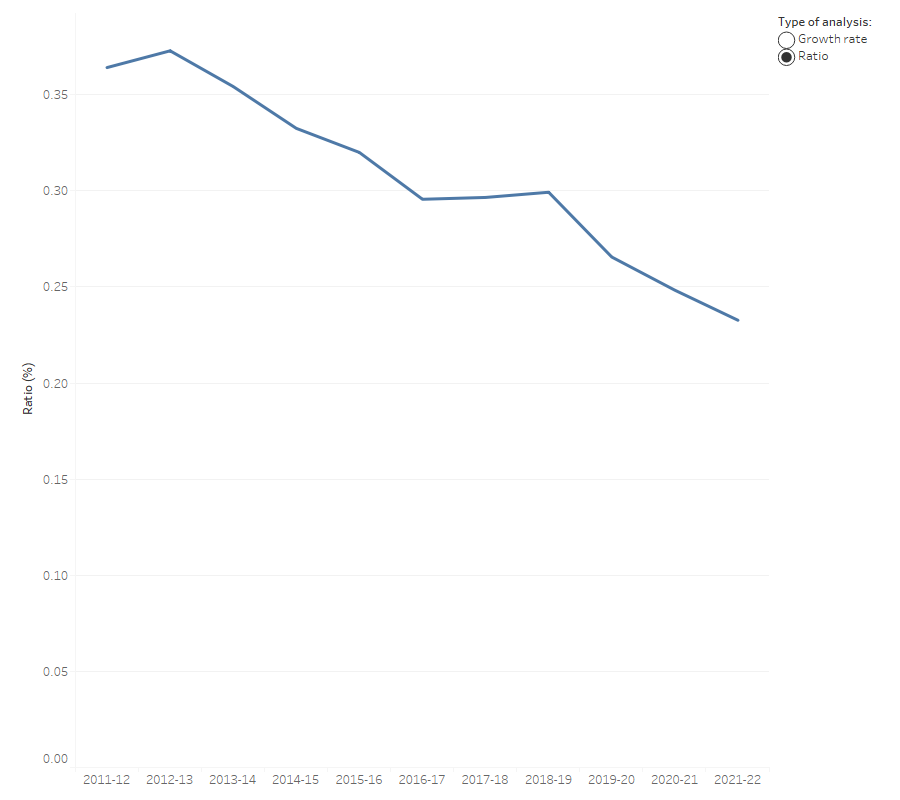
(a) Based on annual estimated resident population (Table 37).
(b) Refers to annualised net worth.
Sources: AIHW Health Expenditure Database; Australian Bureau of Statistics (2022a, 2023b) (Table 27).
About measures of individual income and wealth
To estimate how individuals’ health spending has compared with the financial resources available to individuals, 2 measures are considered:
- income is used to provide a sense of how health spending compared with average earnings throughout the year—how much was spent on health compared with how much earnt in that year
- net worth is used to provide a sense of how health spending compared with the overall wealth position of individuals in a given year, providing a more long-term sense of how health spending compared with personal wealth, particularly where health costs may be too high to be met by regular income.


